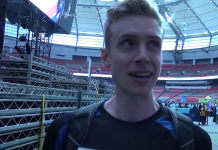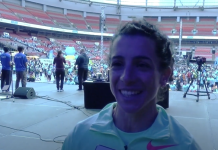© Copyright -2014 – Athletics Illustrated
Providence, Rhode Island’s Kim Smith is one of the all-time great distance runners to emerge from New Zealand. She is originally from Papakura – a suburb of Auckland. She currently owns nine national records in outdoor and indoor track as well as in road running including the half marathon, with her time of 1:07:11.
So far, she has competed in three Olympic Games including the 2004 Athens edition, where she raced the 5,000m distance, 2008 games in Beijing competing in the 10,000m event and finally the 2012 London Games where she was entered into the marathon.
She had an excellent NCAA Division 1 career under famed coach John Treacy, who continues to coach her. She capped her stint at Providence with a national cross country championship win in Terre Haute, Indiana.
Personal bests:
1500 Metres 4:11.25
3000 Metres 8:35.31 NR
5000 Metres 14:45.93 NR
10,000 Metres 30:35.54 NR
10 Kilometres 31:34
Half Marathon 1:07:11 NR
Marathon 2:25:21 NR
Christopher Kelsall: Can you describe growing up in Papakura? Is there a good running environment?
Kim Smith: Papakura is a suburb in south Auckland. When I was a teenager our club there was one of the top two clubs in the country so in that way it was a good running environment. I went to a private high school that had a good coach for my last two years of high school and he really helped me develop as a runner. I didn’t train very hard in high school and I don’t think this was a bad thing for my long term development.
CK: Who were your sporting heroes growing up?
KS: My best friend and her sister, when I was a teenager, was coached by Arthur Lydiard so I would sometimes go with them to stay at his house for training. I would run about half the distance they would but it was always fun hearing his stories about The Peter Snell and Murray Halberg years.
CK: Who do you admire now?
KS: I admire Paula Radcliffe, Deena Kastor and Jo Pavey. I really looked up to them in my early 20s. It’s amazing to see Deena and Jo still running so fast when in their 40s. It’s very inspiring for me now as it gives me hope that I still have a good few years left.
CK: Do you hope to continue running well in your 40s?
KS: Yeah, women like Jo and Deena have really shown that it’s possible.
CK: Did you get to run some of the famous 22-mile, hilly Waitakere route?
KS: No I never have run there. He actually did not live in that area of Auckland when he was older
CK: Listening to Arthur talk at his house, did you find him motivating?
KS: Arthur always told me I was going to be a good runner. My friends would always beat me in races but he used to tell me I was going to be the one to make it. He was brutally honest like that. He told me once I had a body like a boy and that was going to be good for running (not really something you want to hear as an insecure 15 year old girl, ha-ha). Just before he died he was at the 2004 NCAA cross championships and he found me after the race and said “I told ya so.” I’m glad he was there to see that.
CK: Nice story. Is your training modelled after Lydiard’s?
KS: I would say my coach Ray Treacy has similarities to the Lydiard approach. I think most distance runners incorporate this.
CK: What does a typical off-season week look like versus a more quality week, closer to race day?
KS: I’m not really sure there is an off season. I’ve always raced year round. The workouts just get better and feel easier the fitter I get.
CK: Your 67-minute half indicates a possibility of running a 2:22 marathon; is that a goal in the back of your mind?
KS: That was my goal going into London this year. I chose to do London instead of Boston as I wanted a chance to run a fast course which I hadn’t done since my first London marathon. It was really disappointing to do all the training and not be able to race.
CK: So a big motivator then must be not just qualifying for Rio, but nailing that 2:22 time when you are ready?
KS: Yeah it is definitely a big goal. I feel like my 3k to half-marathon times match up well but my marathon time is way off and I’d like to get that down for sure.
CK: What do you think you need to do in training to achieve a marathon time to match your shorter performances? Or is it more about just hitting the right race on the right day?
KS: A lot of the marathon is getting it right on the day. I unfortunately think I’m one of those people whose best distance is the half marathon. The half is great as you can just go out and run hard and fast. There are a lot of other things that come into play while running a marathon. It’s such a long time to be running.
CK: You own something like nine national indoor and outdoor records, any chance you will attempt the full cycle and go after the 1500m record and some of the other more obscure distances?
KS: I think I could have got the 1500m record in 2007-2008, but I haven’t run one since I was in college. The time is past for that now. The marathon training has taken the speed I would need to run that fast!
CK: How did surgery go? Have you been given any indication of what the recovery timeline might be?
KS: The surgeon said the surgery went well. I have had one check up with him so far and he said my transferred tendon was working well. I’m not sure how long the recovery will be. The surgeon said he throws out “normal” recovery times for professional athletes so he will assess things as I go back for my check-ups.
CK: You refer to it as a rupture, did it snap while out on a run?
KS: In 2013 I ran a 10km on the track at Stanford and about half-way in my foot started to hurt and after the race it really hurt. I continued running a few weeks then had some time off then raced in the fall. My foot always was bothering me but not all that bad. Then I decided to do the London Marathon in April. Training went really well but my foot always felt a little weak and sore. Then in my last workout before the race my foot really hurt and I couldn’t walk afterwards. I had an MRI and was given a cortisone shot in my tendon sheath of my posterior tibia tendon which I was told was safe. It felt better and I flew to London did a light workout over there then couldn’t run afterwards. I had time off, then started back running. I was getting a lot of treatment for months and trying to run through it which was really stupid. I got another MRI which showed a completely ruptured tendon. I was pretty shocked as at I had got up to running a 7-mile tempo run at 5:35 pace. I just couldn’t understand why my foot couldn’t go faster and wasn’t working properly. I knew something was wrong but didn’t realize it was so bad. My surgeon told me I should have never got the cortisone shot as it probably weakened the tendon.
CK: Is your primary goal Rio 2016, or is that too far off to consider right now, as you recover?
KS: Yes Rio is the primary goal right now. It is far enough away where I can take my time to get back into fitness and prepare to qualify.











![Thomas Fafard interview after win at 2024 Vancouver Sun Run: “[Tactics] worked really well for me today”](https://athleticsillustrated.com/wp-content/uploads/2024/04/Screenshot-2024-04-22-135113-218x150.png)



Comments are closed.